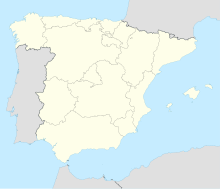Siege of Algeciras (1369)
| Siege of Algeciras (1369) | |||||||
|---|---|---|---|---|---|---|---|
| Part of the Reconquista | |||||||
 Bridge of access to Al-Yazirat Al-Hadra |
|||||||
|
|||||||
| Belligerents | |||||||
|
|
|
||||||
| Commanders and leaders | |||||||
|
|
|
||||||
|
|
|||||||
The Siege of Algeciras (1369) was undertaken during the period of the Reconquest of Spain by Muhammed V, Sultan of Granada to reclaim the city of Al-Hadra Al-Yazirat, called Algeciras by the Christians, in the Kingdom of Castile. The siege lasted just three days, and the sultan was victorious. The Muslims thus regained a major city which had been in Castilian hands since Alfonso XI of Castile took it from the Moroccans after the long 1342-1344 siege. Ten years after the capture of the city, in 1379 the sultan of Granada decided to completely destroy the city to prevent it falling into Christian hands. It was impossible to defend the place at a time when the Muslim kings of the Iberian Peninsula had lost much of military power they enjoyed in earlier centuries.
The city of Al-Hadra Al-Yazirat was the first city founded by the Muslims under Tariq ibn Ziyad in the Iberian Peninsula on the ruins of the Roman city of Iulia Traducta. During the thirteenth and fourteenth centuries it had been held by the rulers of Granada and of Morocco. In was conquered by Alfonso XI of Castile in the Siege of Algeciras (1342–1344). Castilian control of the city of Algeciras was important in giving control of the Strait of Gibraltar to the Christian kingdoms.
However, the death of Alfonso XI during the siege of Gibraltar in 1350 resulted in a civil war between the two successors to the throne of Castile, Peter and Henry II of Castile. Muhammed V of Granada had embarked on a policy of friendship with Castile, supporting Peter as the legitimate heir to the throne. Relations with Aragon however were not as friendly, and the Aragonese supported the proclamation of Muhammed VI as ruler of Granada between 1359 and 1362.
...
Wikipedia

